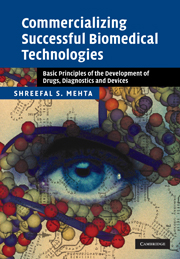 Commercializing Successful Biomedical Technologies
Commercializing Successful Biomedical Technologies Book contents
- Frontmatter
- Contents
- Foreword by F. L. Douglas
- Preface
- Acknowledgements
- 1 The biomedical drug, diagnostic, and devices industries and their markets
- 2 Markets of interest and market research steps
- 3 Intellectual property, licensing, and business models
- 4 New product development (NPD)
- 5 The regulated market: gateway through the FDA
- 6 Manufacturing
- 7 Reimbursement, marketing, sales, and product liability
- Glossary and acronyms
- Index
Preface
Published online by Cambridge University Press: 05 September 2012
- Frontmatter
- Contents
- Foreword by F. L. Douglas
- Preface
- Acknowledgements
- 1 The biomedical drug, diagnostic, and devices industries and their markets
- 2 Markets of interest and market research steps
- 3 Intellectual property, licensing, and business models
- 4 New product development (NPD)
- 5 The regulated market: gateway through the FDA
- 6 Manufacturing
- 7 Reimbursement, marketing, sales, and product liability
- Glossary and acronyms
- Index
Summary
This book will help readers draw a roadmap of the process of taking a biomedical invention and creating a product that can pass regulatory approval to be successfully commercialized. The regulated products included in this context are drugs (both small molecules and biologics), medical devices, diagnostics, and their combination products, as defined by the Food and Drug Administration (FDA) – the regulatory agency that is responsible for overseeing the world's single largest healthcare market, the United States. The term “biomedical technologies” refers to the collective technologies underlying these FDA-regulated products: biotechnology, various engineering technologies, chemistry and materials science, etc.
The book highlights key issues that might help improve chances of success through the complete commercialization process for biomedical technologies and products. This text started as an expansion of a series of lectures given to students at the Lally School of Management and Technology, Rensselaer Polytechnic Institute in Troy, NY as part of a class called “Commercializing biomedical technology.” However, going beyond the classroom in writing this book, information has been taken from many sources and experienced people from industry have contributed to add current and practical information to various segments of the book.
This book could be used to bring science and engineering students together with business and law students, and show them the benefits of approaching this complex process as a team. Many of these students have found the information useful in job interviews and in planning careers in the biotech industry and its service sectors.
- Type
- Chapter
- Information
- Commercializing Successful Biomedical TechnologiesBasic Principles for the Development of Drugs, Diagnostics and Devices, pp. xix - xxiPublisher: Cambridge University PressPrint publication year: 2008
